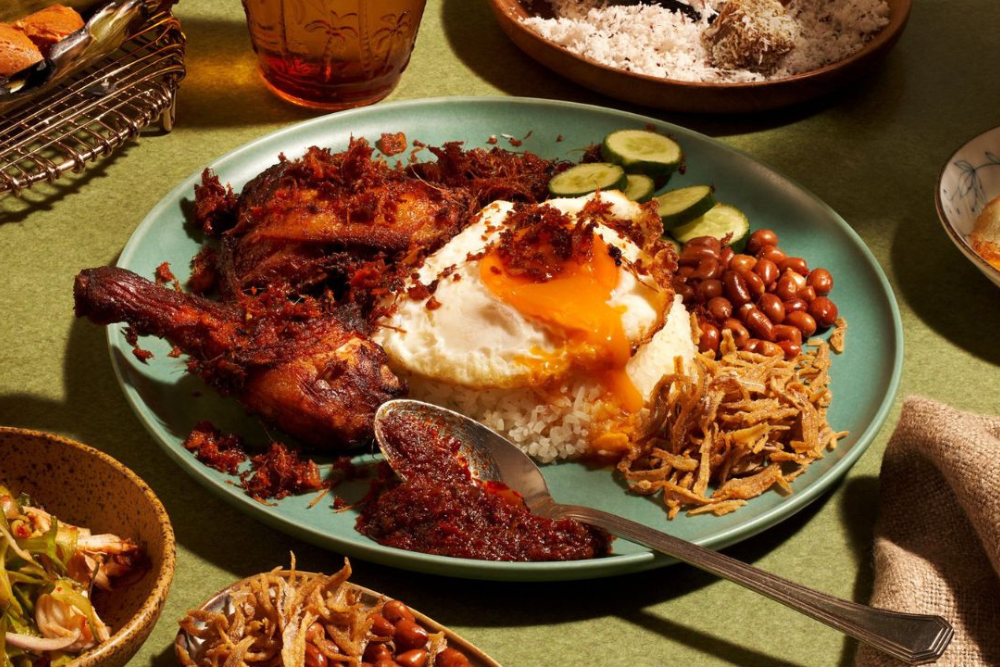Nasi Lemak, often hailed as Malaysia’s national dish, is more than just a meal; it’s a symbol of cultural identity and heritage. This aromatic rice dish wrapped in banana leaves has deep roots in Malaysian history, reflecting the country’s diverse culinary influences. Let’s dive into the fascinating journey of Nasi Lemak and explore how it became an integral part of Malaysian cuisine.
Origins of Nasi Lemak

The term “Nasi Lemak” translates to “rich rice,” referring to the creamy texture of the rice cooked in coconut milk. Its origins can be traced back to the Malay community, where it served as a staple food for farmers and laborers. Traditionally, Nasi Lemak was consumed as an energy-rich meal during long working hours in the fields.
Historical records suggest that Nasi Lemak dates back to the 19th century. It was typically enjoyed during special occasions or festivals. The dish gained popularity due to its affordability and convenience, making it a favorite among locals.
Cultural Significance

Throughout Malaysia’s history, Nasi Lemak has transcended its humble beginnings, becoming a beloved dish among various ethnic groups. It embodies the multicultural nature of Malaysia, where Malays, Chinese, Indians, and indigenous communities all contribute to its unique variations.
Nasi Lemak is often served with sambal (a spicy chili paste), fried anchovies (ikan bilis), toasted peanuts, boiled eggs, and cucumber slices. Each component adds to the flavor profile and nutritional value of the dish. Over time, different regions have adapted their versions of Nasi Lemak, incorporating local ingredients and flavors.
Evolution Through Time

As Malaysia underwent political and social changes throughout the 20th century, so did Nasi Lemak. It transitioned from being a simple farmer’s meal to a gourmet dish enjoyed by all strata of society. In urban areas, food stalls and restaurants began offering elaborate versions of Nasi Lemak, complete with additional toppings like fried chicken or rendang (spicy meat stew).
The rise of food tourism in recent years has further propelled Nasi Lemak into the international spotlight. Food enthusiasts from around the world seek out authentic Malaysian experiences through this iconic dish. Events like food festivals showcase various interpretations of Nasi Lemak, allowing chefs to experiment with flavors while honoring traditional recipes.
The Modern-Day Appeal

Today, you can find Nasi Lemak almost everywhere in Malaysia—from roadside stalls to high-end restaurants. The dish has evolved into a canvas for culinary creativity. Chefs are now incorporating fusion elements like truffle oil or avocado while maintaining its traditional essence.
Despite these modern twists, many still prefer the classic version served on banana leaves for an authentic experience. Eating Nasi Lemak in this manner is not just about savoring flavors; it’s also about honoring tradition and culture.
Nutritional Value
While deliciousness reigns supreme in Nasi Lemak’s appeal, its nutritional value cannot be overlooked. The combination of carbohydrates from rice, healthy fats from coconut milk and peanuts, protein from anchovies or eggs, and vitamins from cucumber creates a balanced meal that satisfies hunger while providing essential nutrients.
However, moderation is key due to its richness. Many Malaysians enjoy it for breakfast or lunch but balance it with lighter meals throughout the day.
Conclusion
Nasi Lemak stands as a testament to Malaysia’s rich history and cultural diversity. This beloved national dish continues to evolve while remaining rooted in tradition. Whether you savor it at a bustling hawker center or enjoy a gourmet version at a fine-dining restaurant, each bite tells a story—one that reflects the heart and soul of Malaysia.
As you explore Malaysia’s culinary landscape, make sure to indulge in this iconic dish that beautifully encapsulates the nation’s heritage. From its humble beginnings to its status as a global culinary sensation, Nasi Lemak remains not just food but an experience steeped in history and culture that every visitor should savor.











